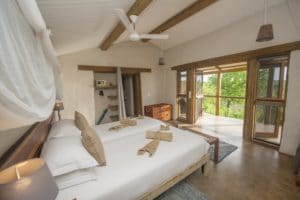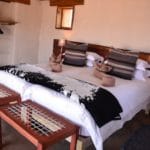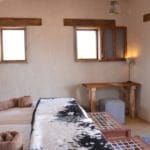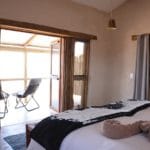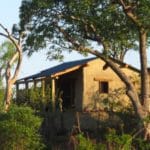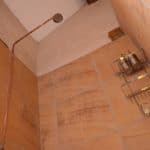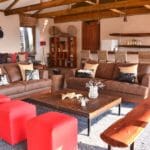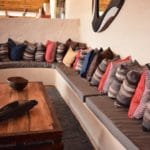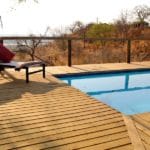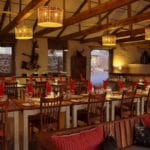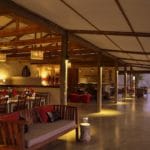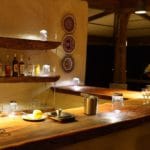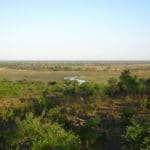Located high on the edge of a rocky ridge overlooking the famous Chobe River is the newly developed Chobe Elephant Camp. This uniquely designed lodge has been built to take advantage of the incredible views overlooking the sweeping floodplains while offering a comfortable refuge from the harsh African conditions.
3 Night Package Inclusions:
- Transfer from Kasane airport to your accommodation
- 3 nights in a chalet with ensuite
- All meals
- All local drinks
- Laundry
- All activities including games drives & boat cruise
- Park fees
- Transfer to Kasane airport
Extra or less nights are available an this can easily be combine with a stay at Victoria Falls or the Okavango Delta
Built from the same red Kalahari sands that dominate the northern part of Botswana, this eco-friendly lodge is ideally positioned to take advantage of everything this incredible destination has to offer. Be it the spectacular wildlife that the Chobe River is famous for, or the opportunity to interact with the local Sibuya Tribe who live within this wildlife haven, Chobe Elephant Camp offers its guest a true African adventure.
Location
Accessible by air via Kasane Airport, Victoria Falls or Livingstone Airports or by road from Savuti, Caprivi or Kasane the lodge is ideally positioned to fit into most safari itineraries.
(GPS Co-ordinates: – S17 56.840 E24 42.055)
Chobe Elephant Camp website
Price per person – USD
| Season | Twin share |
|---|---|
| 01 Apr to 30 Jun 2023 | On request |
| 01 Jul to 31 Oct 2023 | On request |
| 01 to 30 Nov 2023 | On request |
| 01 May to 31 Oct 2023 | On request |
| 01 to 31 Dec 2023 | On request |
3 Night Package Inclusions:
- Transfer from Kasane airport to your accommodation
- 3 nights in a chalet with ensuite
- All meals
- All local drinks
- Laundry
- All activities including games drives & boat cruise
- Park fees
- Transfer to Kasane airport
Extra or less nights are available an this can easily be combine with a stay at Victoria Falls or the Okavango Delta
Accommodation
Chobe Elephant Camp has been designed to capture the feel of the traditional Farmstead located in the African wilderness. Polished floors, exposed wooden beams and weathered furniture capture the feel of rustic charm. Mix this with some contemporary style and the lodge has a unique feel of old meets new and offers the guests something different and unique.
With 12 rooms, Chobe Elephant Camp can comfortably accommodate 24 guests. All rooms are en-suite with both indoor and outdoor showers. The whole lodge has been designed to take advantage of the spectacular views over the Chobe River, so whether you choose to relax on your private veranda, read a book in the lounge, have a drink at the bar or cool off in the pool, the vista will always be there to enjoy.
Based in the semi-arid bush of Africa there is always the challenge of extreme temperature variations and how to combat this. The solution came in one of earths’ great insulators – the sand. The lodge has been entirely constructed from sandbags, the thick sand-filled walls create a natural insulating barrier between the inhabitants and the harsh African climate and enhance the old farm-style feel of the camp.
Keeping the environment in mind, the development has focused on renewable resources wherever possible. From ensuring that all the construction timber and furniture is manufactured from renewable wood sources or from reclaimed wood, to using the sun’s energy to heat the water, Chobe Elephant Camp makes every effort to keep its carbon footprint as small as possible, while at the same time never compromising guest comfort.
Facilities
With a spectacular position overlooking the Chobe river floodplain, Chobe Elephant Camp takes full advantage of the land offering a fantastic feeling of wide open space from your very first step through the doors. Providing a simultaneously rustic and stylish feel, Chobe Elephant Camp was designed to minimise at best its carbon footprint, providing a genuinely eco-friendly gateway to the surrounding natural wonders. The lodge boasts a large open-plan main area featuring a cosy arrangement of couches along with a bar, dining area and reading corner and opens up onto an inviting boma area. From the main area, a small pathway leads down to the swimming pool with viewing deck onto a private waterhole.
Facts
- 10 chalets twin/double with private verandah
- 1 family suite (2 separate units with adjoining lounge)
- Sleeps 24 Guests
- Includes road transfers to and from Kasane
- Includes Game Drives & Cultural Village visit
- 2 night stays or longer, include 1 boat cruise on the Chobe River
- Pool area with viewing deck of private waterhole
- Main Area: 252 m2. Facilities include a Reading corner, Bar, Lounge and Dining Areas
Activities
At Chobe Elephant Camp you will conduct all your activities with local professional guides. These trained professionals will help you to interpret the sounds, smells and sights of the bush and its inhabitants, as well as expose you to the culture of the local people and how they live in this wilderness.
During your stay at Chobe Elephant Camp you will hopefully get the opportunity to experience the big game safari in our custom built open landrovers and/or from a boat on the Chobe River. Finally a walk through the local village will give you a chance to learn about the culture and livelihoods of the local Sibuya tribe.
Activities offered at Chobe Elephant Camp:
- Game Drives
- Cultural experience
- Boat cruises (for guests staying a minimum of 2 nights)
- Full day to Victoria Falls (on request during booking process only)
Surrounds
Northern Botswana is home to the largest population of elephants in Africa, and the life giving waters and rich grazing on the flood plains of the Chobe River attract some of the largest concentrations of these magnificent giants of the bush.
Besides the elephants, the Chobe River and surrounding woodlands supports an incredible diversity of animals and has developed a reputation of being one of the great wildlife destinations in Africa. From large herds of elephants swimming in the Chobe river, zebra and buffalo grazing on the floodplains, giraffes feeding on the acacias trees and shy roan and sable antelope ghosting through the teak forests, there is always something of interest. Combine the above with some of the highest predator densities in Botswana (Lion, Leopard, Wild Dog and Hyaena) and it is clear why this is such a wildlife mecca.
In addition to the mammals, the Chobe River is also home to over three hundred bird species and is one of the top birding destinations in Botswana.
The lodge is also located within the tribal lands of the Sibuya people. The Sibuya inhabit the low lying flood plains that occur between the Chobe River (Botswana) through the Caprivi (Namibia) to the Zambezi River (Zambia). Specialising in subsistence fishing you will see the fishermen crisscrossing the waterways and floodplains in the traditional dugout canoes known as mekoros. Small scale livestock and crop farming is also carried out throughout the region. As this area falls within a wildlife protection zone, there are no fences separating people from wildlife and the Sibuya have learnt to co-exist with the wild animals that call this area home.
At Chobe Elephant Camp you will conduct all your activities with local professional guides. These trained professionals will help you to interpret the sounds, smells and sights of the bush and its inhabitants, as well as expose you to the culture of the local people and how they live in this wilderness.
During your stay at Chobe Elephant Camp you will hopefully get the opportunity to experience the big game safari in our custom built open landrovers and/or from a boat on the Chobe River. Finally a walk through the local village will give you a chance to learn about the culture and livelihoods of the local Sibuya tribe.
Local Attractions
Chobe National Park
Chobe National Park is a large wilderness area covering nearly 11 000 square kilometers, which makes it the third-largest park/game reserve in Botswana.
During the 1930’s Botswana was still a British protectorate known as Bechuanaland. In those days very few people visited the Chobe riverfront, and the area was used mainly for hunting and timber. The large elephant population lured many a hunter to the area during the time when ivory trade was rife, and conservation of wildlife and the environment was not a high priority. The then commissioner of Botswana, Colonel Charles Rey, wanted to proclaim the area a reserve, however his dream was only realised in the early 1960’s when the Chobe National Park came into existence under the Bechuanaland Government proclamation no. 22 of 1961.
The Chobe River forms the northern boundary and in the extreme southwest corner it borders onto Moremi Game Reserve. The primary function of Chobe National Park is the protection of the full range of southern Africa’s large predators, as well as the localized puku antelope and migratory elephant population, which can number up to 70 000.
The Chobe National Park offers extreme contrasts and a variety of wildlife experiences within the confines of one park. It covers a variety of vegetation types and geological features that vary from the almost tropical habitat of the Linyanthi swamp to the severe, desert-like landscape of the Savuti, and from the lush Chobe floodplain grassland to the deep sands of the Brachestegia woodland.
It also has the Mababe Depression with its black cotton soil and Acacia scrub, as well as the pan-studded mopane and Combretum areas at Nogatsaa.
Four main areas have been developed in Chobe (namely: Savuti, Chobe River, Linyanthi, and Nogatsaa), each of which offers a unique experience. The Savuti and Chobe River Front areas will be discussed, since these are the two areas of focus during the trail.



